The future of communication in the world of wine production
Intervista al Dott. Paolo Panerai from SGA Wine design on Vimeo.
The name Paolo Panerai stands for great success in various information sectors, but also in fields of excellence like wine production. Where does your passion for wine come from?
Passion for wine is something genuine and authentic that started when I was a child. I had always lived in the country with all my family in my grandfather’s great house in Florence. When we had the chance, we decided to return to Tuscany to a place we really liked, in the Chianti area, and we started looking for a company. We were lucky: after a day’s searching, we found it and it was like falling in love for the first time. The friendship and professional relationship with Luigi Veronelli was of equal importance. We met at the Panorama magazine and, when we founded the publishing house (Class Editori), he began to write for our magazines, called “L’Etichetta”. So I had the good fortune to be able to explore this passion for wine and knowledge about wine in the company of the greatest writer and philosopher of wine. A connoisseur, who never agreed to blindfolded wine tastings because, for him, it is the totality of the wine that produces that sense of quality or pleasure, or otherwise, through the bottle, the label, knowing the wine’s origin. It’s the expression, the synthesis of many factors, including the territory.
Thank you. You’ve already partly answered my next question: are there other people, other figures who influenced you in addition to Luigi Veronelli?
Certainly, there’s the example of some great producers of Tuscan wine, but not only that… Antinori, Frescobaldi… Reflecting on the fact that these families have been producing wine for centuries and on the continuity in the life of their families that comes from running a wine business. Yet, at the same time, it is also a “new world”. It was with Luigi Veronelli that we made an important tour of America in the seventies when the whole world was discovering California, and the Napa Valley in particular. Meetings with characters like Robert Mondaci, his wine expert son, Tim, or Michael, in charge of distribution, were very stimulating. But the person who influenced me most of all was Edmond de Rothschild, with whom we became partners in a company specialising in importation and the technology of French wine. Edmond had always been part of a separate branch from the French bank, his father had founded a bank in Switzerland, but nevertheless was always the biggest shareholder (now it’s his son, Benjamin) in Chateau Lafite, although not directly involved. Then he got it into his head that he was going to create the Chateau Lafite of the new millennium. He bought a company called Chateau Clarke but died before he could achieve his objective. However, in an act of friendship, he invited us to visit, along with Luigi Veronelli and Maurizio Castelli, who was then our wine expert in the company in Chianti (Castellare) and there we had the good fortune to be able to speak for two entire days with the greatest wine expert of the last hundred years, Emile Peynaud, a professor at Bordeaux University, who helped me understand that it was a good idea – something Veronelli had already concluded – to favour native vines and so, in the specific case of Tuscany, that meant the Sangiovese rather than the Super-Tuscans, produced by mixing international vines.
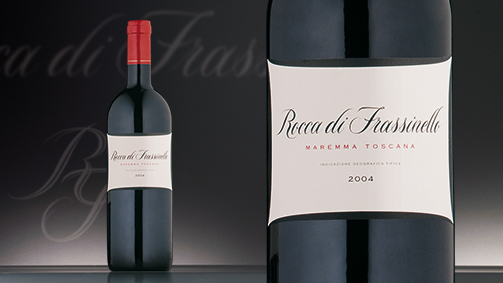
Wine is a product that is increasingly undergoing evolution and stands apart from other categories. How was it advertised in the past? How is it advertised today? And, above all, how will it be advertised in the future, in your opinion?
Originally, it was hunger, because it was a nutritional product that provided calories as part of a diet that was then very poor. Wine was important because it was the stomach that dictated how knowledge of a wine was spread. Gradually, the living standards of Italians improved and, what’s more, calorie was to be found elsewhere. It was gradually realised that, beyond a certain limit, wine is no longer a pleasure, a beneficial product, but can become a problem and so awareness of quality, rather than quantity, became more important. This was a revolution for oenology and viticulture based on quantity, as it had been the case in Italy for a long time. Less so in France, where selection had been practised since 1855, due to the classification imposed by Napoleon III: the vineyards to be uprooted, the ideas to be spread etc. Now a wine’s reputation is based essentially on two values: quality and authenticity, and authenticity soon leads to the consideration of production that is almost 100% organic. Unfortunately, very often vines, like so many other plants, are affected by diseases so, if the destruction of the vineyards is to be avoided, sometimes interventions have to be carried out. I was convinced by this precept from the start and that’s why we’ve always put John Gould’s bird drawings on the labels of the Castellare wines, seeking out the rarest - because for a long time synthetic chemicals were used in the vineyard - when in fact it is possible to achieve balance by using more natural products like green copper etc, thereby preserving the quality. These are the two main threads and, of course, all the rest follows. It isn’t possible to sell just a bottle of wine, the territory itself must be sold using the values of the land, all the more so since, in the meantime, many other countries that were not wine producers have now begun production and, because it is not a very difficult technology to acquire, they can also produce good wines. What makes the difference for Italian wines, therefore, is the overall description of the wine along with the land of its origin, and what that land has to offer, the welcome, the tastings and everything that follows.
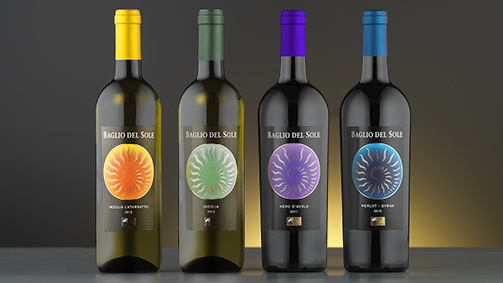
The architectural design of the cellar has become an element that helps establish the reputation of the brand. How important is this aspect, in your opinion?
There are two advantages, like the two sides of a coin. The architectural harmony of the cellar can help to enhance the wine, but if the architectural value of the cellar, as a consequence, exceeds the value of the wine and people become more interested in the cellar than the wine, this strategy loses its effectiveness. In our case, with a very great architect, my great friend of many years, Renzo Piano, we made a cellar with “its feet on the ground” so to speak, recognising the fact that a cellar is a production site. Therefore, starting with the choice of materials, such as the exposed concrete, and the architectural lines, we agreed from the outset that it had to be a functional work place, with the architectural value that an extraordinary artist like Renzo Piano can provide. This practice has become widespread and there are cellars by architects everywhere. In many cases, let’s say, they’ve strayed from the essential value of the wine.
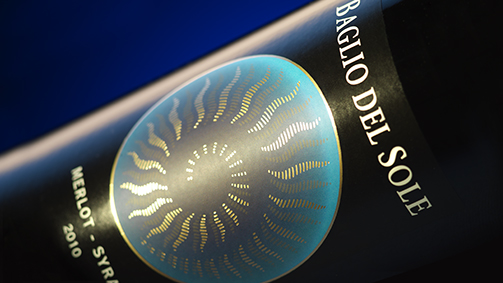
In the history of your wines, there’s the prestigious joint venture with Domaines Barons de Rothschild when, within two years, the great wine, Rocca di Frassinello 2004, was awarded two Gambero Rosso wine glasses, followed by three for the 2006 vintage and three Veronelli stars. A continuous search for excellence. What does excellence mean to you?
Actually, it was my old friendship with Edmond de Rothschild that provided the link with the cousins, who run Chateau Lafite and, especially, with Eric. This relationship was cemented by the fact that, as bankers, they had been our advisers on the stock market listing of the publishing house. A real bridge was formed between publishing, finance and wine. Eric is a very curious person. One day, we were in Maremma having lunch at the Gambero Rosso – Fulvio Pierangelini is no longer there now – and I told him I had bought a holding not far from there, since it was very difficult to find land in Chianti and there were also many constraints. As a result, there had been this shift towards Maremma where more land was available. We went to the place and, seeing there was a small patch of vines, he was curious: “Where is the wine?” he asked. I answered: “I don’t know where the wine is because the farmer takes care of it. I don’t even know what kind of vines there are.”
But he wanted to taste it and, with his characteristic understatement, he said: “Ah, this wine is good”.. and so on, and he asked: “How many hectares are there?” And I told him: “There are 50 hectares.” “You can’t do anything with 50 hectares because as the French say: ‘C’est une affaire foncière.’ You need many more hectares. If you can get 500 hectares, we can start a company.” So the company was founded and it was the first joint venture between Italy and France, the two major wine producing countries of the world, both in terms of quantity and quality. The search for excellence was implicit. At the beginning, two wine experts were working together: Lafite’s wine expert and ours, Alessandro Cellai, now a major figure in this world. The wines took off much earlier than anyone imagined and, in this case, let’s say, precisely because it was a joint venture between the two countries, bringing native vines together, so Sangiovese with international, French vines. But the research never ends…
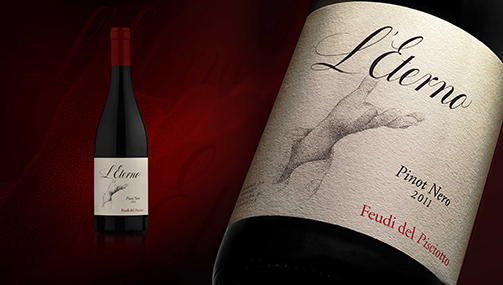
How important is the outer appearance of a wine in determining its success?
I would say, as far as we are concerned, it has been vitally important and, I believe, this is true for everyone. When we left – now there’s been some misuse, some copying of our initial Castellare label – the idea of using Gould’s beautiful drawings, someone who had been a great ornithologist, and linking him to this idea of protecting the land and the fauna by taking care of the vineyard. Not using any chemical products, which are what destroy the fauna and aren’t good for the person who drinks the wine, was typical of this approach. For a long time now, we’ve heard people say: “Ah, this is the wine with the labels depicting birds.” It is vital to trust the professionals. For me, that first label was a lot of work, alongside an intelligent graphic artist that I had when I was editor of “Mondo”, but then, in order to always proceed at the highest level, what was needed was a quality graphic that expressed the value of the wine in the way you want it to. So if the philosophy a wine is elegance, the labels must be extremely elegant and stay in the mind. It’s as if you place a sort of photograph in the mind of the consumer that enables the wine to be immediately recognised by its label.
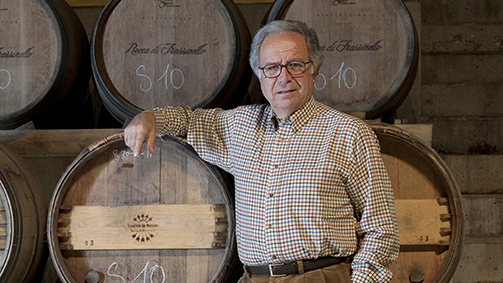
A final question: in what way did your vast experience in the publishing and economic-financial fields contribute to the creation of your wine production business?
The publishing experience has only been useful in terms of knowing how to communicate. As a deliberate choice, I’ve never mixed publishing with oenology in the sense that publishing involves a company listed on the stock market while wine is something personal. All the events we stage leave people asking: “Is this wine yours?” “No”, I say, “it’s not mine!” because we never do that. The only exception we made was some time ago in Shanghai where we presented two initiatives for China: an issue of ‘Gentleman’ in Chinese and the information system for Chinese tourists, who will be a fundamental factor for Italy, but also for the wine, which is called Excellence of Italy, made with Xinhua, New China Agency. In those circumstances, we had to use our own wines because in the restaurant of the hotel where we were staying, the Ritz-Carlton, they were the ones available. But we never try to mix the two things. Obviously, there is a transfer of experience from publishing, as regards communication, which is an advantage for the wine. And from the world that wine represents, the philosophy it implicitly contains, come values that can also be applied in the publishing sector.


